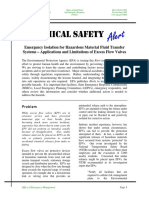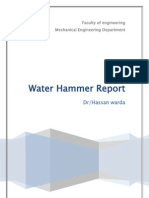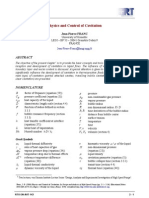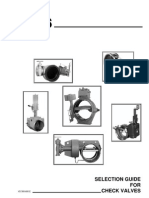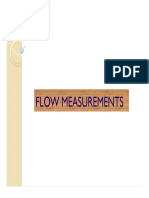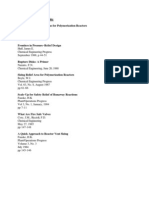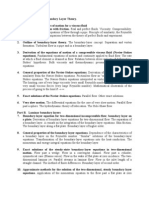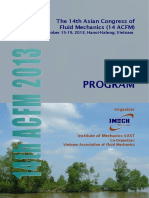Water Hammer: The Magnitude of The Pulse
Water Hammer: The Magnitude of The Pulse
Uploaded by
Khaled SolimanCopyright:
Available Formats
Water Hammer: The Magnitude of The Pulse
Water Hammer: The Magnitude of The Pulse
Uploaded by
Khaled SolimanOriginal Description:
Original Title
Copyright
Available Formats
Share this document
Did you find this document useful?
Is this content inappropriate?
Copyright:
Available Formats
Water Hammer: The Magnitude of The Pulse
Water Hammer: The Magnitude of The Pulse
Uploaded by
Khaled SolimanCopyright:
Available Formats
Water hammer
Water hammer (or, more generally, fluid hammer) is a pressure
surge or wave resulting when a fluid in motion is forced to stop
or change direction suddenly (momentum change). Water
hammer commonly occurs when a valve is closed suddenly at
an end of a pipeline system, and a pressure wave propagates
in the pipe.
The magnitude of the pulse
Water hammer can be analyzed by two different approaches, rigid column theory which ignores
compressibility of the fluid and elasticity of the walls of the pipe, or by a full analysis including
elasticity. When the time it takes a valve to close is long compared to the propagation time for a
pressure wave to travel the length of the pipe, then rigid column theory is appropriate; otherwise
considering elasticity may be necessary[1]. Below are two approximations for the peak pressure,
one that considers elasticity, but assumes the valve closes instantaneously, and a second that
neglects elasticity but includes a finite time for the valve to close.
The maximum magnitude of the water hammer pulse, assuming a valve that closes instaneously,
can be estimated from the Joukowsky equation P = aC, where P is the magnitude of the
pressure wave (Pa), is the density of the fluid (kgm3), a is the speed of sound in the fluid (ms1),
and C is the change in the fluid's velocity (ms1). The pulse comes about due to Newton's laws of
motion and the continuity equation applied to the deceleration of a fluid element.
As the speed of sound in a fluid is the , the peak pressure will depend on the fluid compressibility
if the valve is closed abruptly. When the valve is closed slowly compared to the transit time for a
pressure wave to travel the length of the pipe, the elasticity can be neglected, and the phenomenon
can be described in terms of intertance or rigid column theory. For this case, one approximation to
the maximum pressure (using Imperial units), P, produced in a water filled line is : P = 0.07VL / t + P1
where P1 is the inlet pressure, V is the flow velocity in ft/sec, t is the valve closing time in seconds
and L is the upstream pipe length in feet. To keep water hammer low, pipe-sizing charts for some
applications recommend flow velocity at or below 5 ft/s (1.5 m/s).
Effects and mitigation
If the pipe is suddenly closed at the outlet (downstream), the mass of water before the closure is still
moving forward with some velocity, building up a high pressure and shock waves. In plumbing this
is experienced as a loud bang resembling a hammering noise. Water hammer can cause pipelines or
equipment such as filter housing to break if the pressure is high enough. Air traps or stand pipes
(open at the top) are sometimes added as dampers to water systems to provide a cushion to absorb
the force of moving water in order to prevent damage to the system. (At some hydroelectric
generating stations what appears to be a water tower is actually one of these devices.)
On the other hand, when a valve in a pipe is closed, the water downstream of the valve will attempt
to continue flowing, creating a vacuum that may cause the pipe to collapse or implode. This problem
can be particularly acute if the pipe is on a downhill slope. To prevent this, air and vacuum relief
valves, or air vents, are installed just downstream of the valve to allow air to enter the line and
prevent this vacuum from occurring[citation needed].
Dynamic Equations
The water hammer effect can be simulated by solving the following partial differential equations
where V is the fluid velocity inside pipe, is the fluid density and Bm is the equivalent bulk modulus,
f is the friction factor.
Possible causes
Sudden valve closure, Pump failure , Check valve slam (due to
sudden deceleration, a check valve may slam shut rapidly,
depending on the dynamic characteristic of the check valve
and the mass of the water between a check valve and tank).
Software
Most water hammer software packages use the method of characteristics to solve the differential
equations involved. This method works well if the wave speed does not vary in time due to either air
or gas entrainment in a pipeline. Many commercial and non commercial packages exist today.
Software packages vary in complexity, dependent on the processes modeled. The more sophisticated
packages may have any of the following features:
Multiphase ow capabilities
An algorithm for cavitation growth and collapse
Unsteady friction - the pressure waves will dampen as turbulence is generated and due to variations
in the ow velocity distribution
Varying bulk modulus for higher pressures (water will become less compressible)
Fluid structure interaction - the pipeline will react on the varying pressures and will cause pressure
waves itself
Mitigating measures
Water hammer has caused accidents and fatalities, but is usually less threatening. In many cases
damage is limited to breakage of pipes or appendages. An engineer should always assess (at least
qualitatively) risk of a pipeline burst. Pipelines with hazardous goods should always receive special
attention and should be thoroughly investigated.
The following characteristics may reduce or eliminate water hammer:
Low uid velocities.
Slowly closing valves. Toilet ush valves are available in a quiet ush type that closes quietly.
High pipeline pressure rating (expensive).
Good pipeline control (start-up and shut-down procedures).
Water towers (used in many drinking water systems) help maintain steady ow rates and trap large
pressure uctuations.
Air vessels work in much the same way as water towers, but are pressurized. They typically have an
air cushion above the uid level in the vessel, which may be regulated or separated by a bladder.
Sizes of air vessels may be up to hundreds of cubic meters on large pipelines. They come in many
shapes, sizes and configurations. Such vessels often are called accumulators.
Air valves are often used to remediate low pressures at high points in the pipeline. Though effective,
sometimes large numbers of air valves need be installed. These valves also allow air into the system,
which is often unwanted.
Shorter branch pipe lengths.
Shorter lengths of straight pipe, i.e. add elbows, expansion loops. Water hammer is related to the
speed of sound in the uid, and elbows reduce the inuences of pressure waves.
Arranging the larger piping in loops that supply shorter smaller run-out pipe branches. With looped
piping, lower velocity ows from both sides of a loop can serve a branch.
UPS (uninterruptible power supply) is sometimes installed to dampen the initial pressure wave by
keeping the system running for some time after a power trip.[citation needed]
Flywheel on pump.
Pumping station bypass.
You might also like
- Excess FLow ValveDocument9 pagesExcess FLow ValvechloeNo ratings yet
- Fluid Mechanics Water Hammer ReportDocument17 pagesFluid Mechanics Water Hammer ReportHarryzam MartelNo ratings yet
- Water Hammer ReportDocument16 pagesWater Hammer Reportahemdmohi90% (10)
- Pumps & Pumping Systems-GeneralDocument349 pagesPumps & Pumping Systems-GeneralKondala RaoNo ratings yet
- Waterhammer Potential in Pumps and SystemsDocument16 pagesWaterhammer Potential in Pumps and Systemseuric82No ratings yet
- Surge Pressure Formula PDFDocument3 pagesSurge Pressure Formula PDFnirmal_subudhi100% (1)
- BKR WhitePaper WaterHammerDocument4 pagesBKR WhitePaper WaterHammerThuc TruongNo ratings yet
- Water Hammer - Wikipedia, The Free EncyclopediaDocument8 pagesWater Hammer - Wikipedia, The Free Encyclopediarohan kumarNo ratings yet
- Water Hammer: Cause and EffectDocument8 pagesWater Hammer: Cause and Effectmn_sundaraamNo ratings yet
- How To Control SurgeDocument22 pagesHow To Control SurgeGlishna Peushan WidanapathiranaNo ratings yet
- Lecture On SurgeDocument42 pagesLecture On SurgeJaspal SinghNo ratings yet
- Impulse LoadingDocument14 pagesImpulse LoadingAmr BadranNo ratings yet
- Surge Control PDFDocument14 pagesSurge Control PDFMohamed Guezguez100% (1)
- Water HammerDocument52 pagesWater HammerNidas Sameera100% (1)
- Methodology ArticleDocument6 pagesMethodology ArticleItalo AdottiNo ratings yet
- Controlling Surges in Liquid Pipelines 6020.1Document6 pagesControlling Surges in Liquid Pipelines 6020.1alyshah100% (1)
- Surge CalculationsDocument21 pagesSurge CalculationsSri DharNo ratings yet
- Water Hammer ReferenceDocument5 pagesWater Hammer ReferenceAmit SawantNo ratings yet
- Dynamic Testing of CheckvalveDocument10 pagesDynamic Testing of Checkvalveamirthraj74No ratings yet
- Physics and Control of Cavitation: Jean-Pierre FRANCDocument36 pagesPhysics and Control of Cavitation: Jean-Pierre FRANCSahr EmmanuelNo ratings yet
- Vaporous Cavitation Is The Most Common Form of Cavitation Found in Process Plants. Generally It OccursDocument4 pagesVaporous Cavitation Is The Most Common Form of Cavitation Found in Process Plants. Generally It OccursArun AzhakesanNo ratings yet
- Cavitation: Causes, Effects and ApplicationDocument21 pagesCavitation: Causes, Effects and Applicationhossam gamalNo ratings yet
- Common Valve ProblemsDocument76 pagesCommon Valve ProblemsAhmed Sabry El-sotohy100% (1)
- An Introduction To Cavitation FundamentalsDocument18 pagesAn Introduction To Cavitation FundamentalsJaqueline GontijoNo ratings yet
- Water Hammer ArticleDocument14 pagesWater Hammer ArticleayoungaNo ratings yet
- CT 5550 Pumping Stations and Transport PipelinesDocument45 pagesCT 5550 Pumping Stations and Transport PipelineshamanoelgenNo ratings yet
- Charts For Water Hammer in Low Head Pump Discharge PDFDocument26 pagesCharts For Water Hammer in Low Head Pump Discharge PDFotilem1992No ratings yet
- A Novel Method of Using A Control Valve For Measurement and Control of Flow - Instrumentation and Measurement, IEEE Transactions OnDocument3 pagesA Novel Method of Using A Control Valve For Measurement and Control of Flow - Instrumentation and Measurement, IEEE Transactions OnBhuvanaNo ratings yet
- Prediction of Flow Coefficient and Hydrodynamic Torque Coefficient in Butterfly ValveDocument5 pagesPrediction of Flow Coefficient and Hydrodynamic Torque Coefficient in Butterfly ValveRajeshNo ratings yet
- D - Two-Phase Flow Lab ManualDocument23 pagesD - Two-Phase Flow Lab ManualdanielNo ratings yet
- SRV NoiseDocument7 pagesSRV NoisebbmokshNo ratings yet
- Selection GuideDocument12 pagesSelection GuideMiguel Angel VasquezNo ratings yet
- MEC2404 Frictional Flow in Pipe Lab RepoDocument10 pagesMEC2404 Frictional Flow in Pipe Lab Repoatik100% (1)
- Structural Analysis of Non Return Control Valve Using Finite Element AnalysisDocument5 pagesStructural Analysis of Non Return Control Valve Using Finite Element AnalysisAulia RahmanNo ratings yet
- Water HammerDocument6 pagesWater HammerKhaled SolimanNo ratings yet
- Size Control Valves For Lab-Scale Laminar Flow: Fluids and Solids HandlingDocument5 pagesSize Control Valves For Lab-Scale Laminar Flow: Fluids and Solids HandlingNattapong PongbootNo ratings yet
- Flow MeasurementsDocument30 pagesFlow MeasurementsGaganNo ratings yet
- Cavitation Analysis CFDDocument4 pagesCavitation Analysis CFDshdjjfNo ratings yet
- 2024.02.21 Stop Cavitation From Destroying Your Control Valve TrimsDocument3 pages2024.02.21 Stop Cavitation From Destroying Your Control Valve Trimsredlion510No ratings yet
- Review of Advancement in Variable Valve ActuationDocument20 pagesReview of Advancement in Variable Valve ActuationSONU PRAVEENNo ratings yet
- (Elearnica) - Hardfacing Technologies For Improvement of Wear Characteristics of Hot WorkDocument13 pages(Elearnica) - Hardfacing Technologies For Improvement of Wear Characteristics of Hot WorkelmiraNo ratings yet
- Pump IntakeDocument6 pagesPump IntakeAnonymous CMS3dL1T100% (1)
- Industrial Process Control ValvesDocument36 pagesIndustrial Process Control Valvesffown100% (1)
- 2010 Water HammerDocument26 pages2010 Water Hammerbalas838541No ratings yet
- Water Hammer With Column SeparationDocument88 pagesWater Hammer With Column SeparationVSMS8678No ratings yet
- Two Phase Flow BibliographyDocument41 pagesTwo Phase Flow BibliographyShiv Pratap SinghNo ratings yet
- Inertial Cavitation: Lord Rayleigh PressureDocument4 pagesInertial Cavitation: Lord Rayleigh PressureChemicalengineersaqiNo ratings yet
- Vortex-Induced Air EntrainmentDocument9 pagesVortex-Induced Air EntrainmentManikandanNo ratings yet
- Water Hammer Calculation FormulasDocument6 pagesWater Hammer Calculation FormulasAvinash Vasudeo100% (1)
- Water Hammer in Piping System-Part 1Document14 pagesWater Hammer in Piping System-Part 1Việt Đặng XuânNo ratings yet
- Fluid Mechanics & Machinery: Topic: Water Hammer in PipesDocument12 pagesFluid Mechanics & Machinery: Topic: Water Hammer in PipesLoga MadishNo ratings yet
- Liquid Pipelines Surge Basic ExplainationDocument6 pagesLiquid Pipelines Surge Basic Explainationbryandown100% (1)
- Water HammerDocument30 pagesWater Hammerbhavesh shuklaNo ratings yet
- Water Hammer PDFDocument30 pagesWater Hammer PDFbhavesh shukla100% (2)
- Draft Proposal (31-01-20107)Document11 pagesDraft Proposal (31-01-20107)Ahsan MurtazaNo ratings yet
- Investigation of Water Hammer Effect Through Pipeline SyDocument6 pagesInvestigation of Water Hammer Effect Through Pipeline SyEmnNo ratings yet
- Transients in Hydraulic Systems - Bentley HammerDocument52 pagesTransients in Hydraulic Systems - Bentley HammerEdwin Rafael Puma Coricaza100% (2)
- Draft Proposal (01-02-20107)Document14 pagesDraft Proposal (01-02-20107)Ahsan MurtazaNo ratings yet
- Study The Water Hammer Phenomena It's Causes and Solutions: M.SC. Mudafer Kadum Kredi M.SC. Lammia'a Abdulrudah AbdDocument25 pagesStudy The Water Hammer Phenomena It's Causes and Solutions: M.SC. Mudafer Kadum Kredi M.SC. Lammia'a Abdulrudah AbdYazNo ratings yet
- Types of Valves in Piping: Types of Valves - Tables to estimate man hours of assemblyFrom EverandTypes of Valves in Piping: Types of Valves - Tables to estimate man hours of assemblyNo ratings yet
- Geography of The UKDocument5 pagesGeography of The UKKhaled SolimanNo ratings yet
- Geography of UK4Document12 pagesGeography of UK4Khaled SolimanNo ratings yet
- Geography of UK2Document5 pagesGeography of UK2Khaled Soliman100% (1)
- Khaled Rashed Selieman: AddressDocument2 pagesKhaled Rashed Selieman: AddressKhaled SolimanNo ratings yet
- UK Great Britain (England, Wales, Scotland) & Northern IrelandDocument1 pageUK Great Britain (England, Wales, Scotland) & Northern IrelandKhaled SolimanNo ratings yet
- Boiler &furnaces&incine Rators: Helwan University Faculty of Engineering Mechanical Power DapartDocument5 pagesBoiler &furnaces&incine Rators: Helwan University Faculty of Engineering Mechanical Power DapartKhaled SolimanNo ratings yet
- Cole CurriculumvitaeDocument43 pagesCole CurriculumvitaeKhaled SolimanNo ratings yet
- Dke672 ch4Document43 pagesDke672 ch4Khaled SolimanNo ratings yet
- Determine The Average Pumping Rate of The Discharge Pump in MGD (Million Gallon Per Day) For The Information Given in The Following DiagramDocument1 pageDetermine The Average Pumping Rate of The Discharge Pump in MGD (Million Gallon Per Day) For The Information Given in The Following DiagramKhaled SolimanNo ratings yet
- Helwan University Faculty of Engineering Mechanical Power DepartDocument3 pagesHelwan University Faculty of Engineering Mechanical Power DepartKhaled SolimanNo ratings yet
- Water HammerDocument6 pagesWater HammerKhaled SolimanNo ratings yet
- Connections Program #5: Understanding The Animals: Pre-TeachingDocument8 pagesConnections Program #5: Understanding The Animals: Pre-TeachingKhaled SolimanNo ratings yet
- Abbreviations MeaningDocument1 pageAbbreviations MeaningKhaled SolimanNo ratings yet
- Pre Teaching ActivitiesDocument5 pagesPre Teaching ActivitiesKhaled SolimanNo ratings yet
- Colorectal Cancer, Commonly Known As Colon Cancer or Bowel Cancer, Is ADocument1 pageColorectal Cancer, Commonly Known As Colon Cancer or Bowel Cancer, Is AKhaled SolimanNo ratings yet
- Connections Program #5 Understanding The Animals: Marine Animal Rescue StoryDocument20 pagesConnections Program #5 Understanding The Animals: Marine Animal Rescue StoryKhaled SolimanNo ratings yet
- Energy Performance Assessment of Hvac SystemsDocument4 pagesEnergy Performance Assessment of Hvac SystemsKhaled SolimanNo ratings yet
- 1-Energy Performance Assessment of BoilersDocument7 pages1-Energy Performance Assessment of BoilersKhaled SolimanNo ratings yet
- Sabp A 049 PDFDocument10 pagesSabp A 049 PDFWalid Megahed100% (1)
- Schlichting 1979Document3 pagesSchlichting 1979neesonmNo ratings yet
- 43 (Lecture - Instrumentation For P&ID's - Cookbook)Document55 pages43 (Lecture - Instrumentation For P&ID's - Cookbook)Darkmatter DarkmatterrNo ratings yet
- Flight Stability and Control of Tailless Lambda Unmanned AircraftDocument5 pagesFlight Stability and Control of Tailless Lambda Unmanned AircraftDr Pascual MarquesNo ratings yet
- Arts Fluid FlowDocument142 pagesArts Fluid Flowchem.tahirNo ratings yet
- Loro SiphonicDocument44 pagesLoro SiphonicdanateoNo ratings yet
- Pump Definition Types Advantages Disadvantages Applications With PDFDocument8 pagesPump Definition Types Advantages Disadvantages Applications With PDFSatyam BNo ratings yet
- Valve Sizing TablesDocument5 pagesValve Sizing TablesTanjungNo ratings yet
- Politeknik MalasiyaDocument30 pagesPoliteknik MalasiyaA SNo ratings yet
- Gradually Varied Flow (GVF)Document15 pagesGradually Varied Flow (GVF)Boos yousufNo ratings yet
- Product Design and Testing at Moog: Turning High Performance Into RealityDocument9 pagesProduct Design and Testing at Moog: Turning High Performance Into RealityyounessNo ratings yet
- Forced ConvectionDocument5 pagesForced ConvectionNkoshiEpaphrasShoopalaNo ratings yet
- Flow in Pipes CompleteDocument21 pagesFlow in Pipes CompleteSYaz WAni67% (6)
- Exp 1 PhenDocument5 pagesExp 1 Phensoran najebNo ratings yet
- Pump Course Material Chapter 1Document8 pagesPump Course Material Chapter 1engr victorNo ratings yet
- Pump: Fluid:: Pump Data Sheet - CECO FybrocDocument1 pagePump: Fluid:: Pump Data Sheet - CECO FybrocWael WaelNo ratings yet
- THM General CatalogueDocument20 pagesTHM General CatalogueRohit PaliwalNo ratings yet
- Impacts of Wave-Induced Seabed Response On Local Scour Around A Pipeline - PORO-FSSI-SCOUR-FOAM - ScienceDirectDocument92 pagesImpacts of Wave-Induced Seabed Response On Local Scour Around A Pipeline - PORO-FSSI-SCOUR-FOAM - ScienceDirectgeo ghallabNo ratings yet
- Heat Exchanger DesignDocument8 pagesHeat Exchanger DesignFitriahFindiatiNo ratings yet
- Revision FluidDocument4 pagesRevision FluidPrince VinceNo ratings yet
- A Review of Heat Exchanger Tube Bundle Vibrations in Two-Phase Cross-FlowDocument19 pagesA Review of Heat Exchanger Tube Bundle Vibrations in Two-Phase Cross-FlowPeerasak ArunNo ratings yet
- Program: The 14th Asian Congress of Fluid Mechanics (14 ACFM)Document46 pagesProgram: The 14th Asian Congress of Fluid Mechanics (14 ACFM)TiendatHoangNo ratings yet
- VTT SMP11 JMartio2 PDFDocument7 pagesVTT SMP11 JMartio2 PDFHayderAlSamawiNo ratings yet
- PSV Calculation PSV-201Document1 pagePSV Calculation PSV-201ASHWINI BHOSALENo ratings yet
- Fast Drill Borehole ManagementDocument18 pagesFast Drill Borehole ManagementLucas CabralNo ratings yet
- Design of Hydrofoil UsingDocument18 pagesDesign of Hydrofoil Usingmarihomenon100% (1)
- Equiflow Autonomous Inflow Control Device: Next Generation Icd Increases Recoverable Reserves and Extends Well ProductionDocument2 pagesEquiflow Autonomous Inflow Control Device: Next Generation Icd Increases Recoverable Reserves and Extends Well ProductionMikhaelrams RamsNo ratings yet
- Landjobopagou 2020Document15 pagesLandjobopagou 2020GhulamNo ratings yet
- The Computer Simulation of Dispersed Two Phase Flows David Hill PHD 1998Document371 pagesThe Computer Simulation of Dispersed Two Phase Flows David Hill PHD 1998AghajaniNo ratings yet
